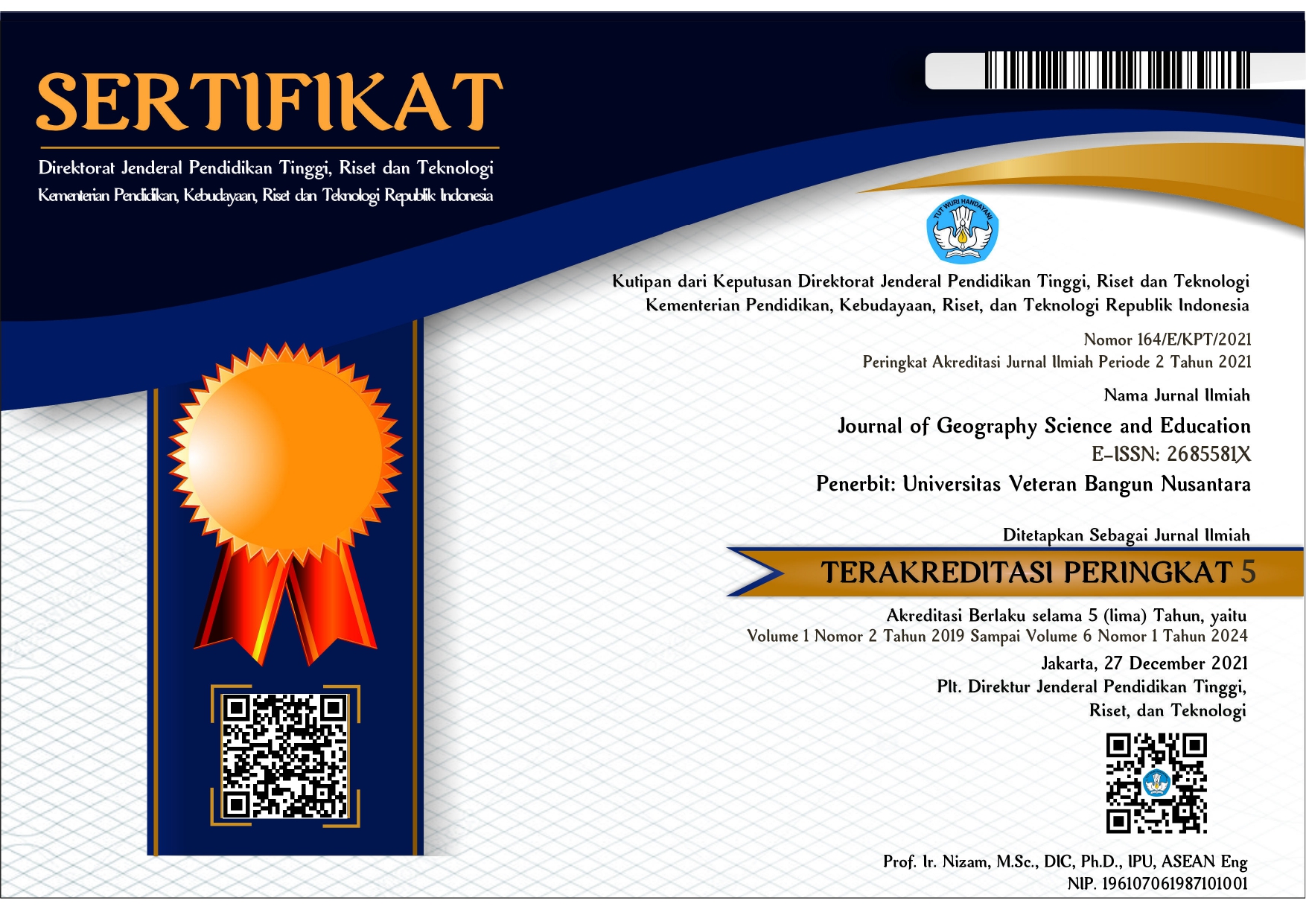The Use of Audio Visual Video Media on Understanding the Concept of Disaster Mitigation of Geographic Education Students of Veteran Bangun Nusantara Sukoharjo University
DOI:
https://doi.org/10.32585/.v2i1.856Abstrak
The learning of Disaster Mitigation Material needs to be given to student teacher’s candidate, so the college students have the understanding about the importance of disaster Mitigation because Indonesia is included in the Pacific Ring of Fire. This research aims to analyze the understanding of disaster mitigation concept of students before and after given learning material by using Audio Visual Video media to the early level college students. This uses quantitative research with an experimental approach. The population on this research are college students at semester 1 & 3 of Geography Education in the odd semester of 2017/2018 academic year with 24 participants. The data collecting techniques use test, student’s worksheet and questionnaire. Data analysis technique uses normality test statistic, homogeneity and T test with the aid of SPSS statistic 21. The results of this research shows that 1) there are differences in the results of student’s understanding of mitigation concepts by using audio-visual video media before and after treatment, 2) by using video, students give a positive respond on the learning process.
Unduhan
Referensi
Anitah, Sri. (2010). Media Pembelajaran. Surakarta: Yuma Pustaka.
Arsyad, Azhar. (2007). Media Pembelajaran. Jakarta: RajaGrafindo Persada.
Gatut Priyowidodo. (Vol.13 No. .Januari 2013, hlm 47-61). Literasi Mitigasi Bencana Tsunami Untuk Masyarakat Pesisir Di Kabupaten Pacitan Jawa Timur. JURNAL EKOTRANS. Padang; Pusat Studi Ekonomi dan Sosial Lembaga Penelitian & Pengabdian Masyarakat Universitas Ekasakti.
Gunawan, A. M. (2013). Statistik untuk Penelitian Pendidikan. Yogyakarta: Parama Publishing.
http://pgsd.uad.ac.id/pentingnya-penanaman-mitigasi-bencana-sejak-dini.
McMillan, H.J. & Schumacher, S. (2001). Research in Education a Conceptual Introduction. New York & London: Longman.
Prasetya, P. S. (2014). Media Pembelajaran Geografi. Yogyakarta: Ombak.
Purwanto, Edy. (2014). Strategi Pembelajaran Bidang Studi. Yogyakarta: Ombak.
Sudjana, N. & Rivai, A. (2013). Media Pengajaran. Bandung: Sinar Baru Algensindo.
Sumaatmadja, Nursid. (1997). Metodologi Pengajaran Geografi. Jakarta: Bumi Aksara.
Syamsul Maarif. (Vol 3 No 1 Tahun 2012).Konsistensi Pengetahuan dan Pemaknaan Tentang Ancaman Bencana Alam (Studi Kasus Ancaman Bencana Gunung Merapi) JURNAL PENANGGULANGAN BENCANA. Jakarta: Pusat Data Informasi dan Humas Badan Nasional Penanggulangan Bencana.
Unduhan
Cara Mengutip
Terbitan
Bagian
Lisensi
License and Copyright Agreement
In submitting the manuscript to the journal, the authors certify that:
- They are authorized by their co-authors to enter into these arrangements.
- The work described has not been formally published before, except in the form of an abstract or as part of a published lecture, review, thesis, or overlay journal. Please also carefully read JGSE's Posting Your Article Policy at http://pubs2.ascee.org/index.php/ijele/about/editorialPolicies#custom-5
- That it is not under consideration for publication elsewhere,
- That its publication has been approved by all the author(s) and by the responsible authorities – tacitly or explicitly – of the institutes where the work has been carried out.
- They secure the right to reproduce any material that has already been published or copyrighted elsewhere.
- They agree to the following license and copyright agreement.
Copyright
Authors who publish with Journal of Geography Science and Education agree to the following terms:
- Authors retain copyright and grant the journal right of first publication with the work simultaneously licensed under a Creative Commons Attribution License (CC BY-SA 4.0) that allows others to share the work with an acknowledgment of the work's authorship and initial publication in this journal.
- Authors are able to enter into separate, additional contractual arrangements for the non-exclusive distribution of the journal's published version of the work (e.g., post it to an institutional repository or publish it in a book), with an acknowledgment of its initial publication in this journal.
- Authors are permitted and encouraged to post their work online (e.g., in institutional repositories or on their website) prior to and during the submission process, as it can lead to productive exchanges, as well as earlier and greater citation of published work.
Licensing for Data Publication
Journal of Geography Science and Education use a variety of waivers and licenses, that are specifically designed for and appropriate for the treatment of data:
- Open Data Commons Attribution License, http://www.opendatacommons.org/licenses/by/1.0/ (default)
- Creative Commons CC-Zero Waiver, http://creativecommons.org/publicdomain/zero/1.0/
- Open Data Commons Public Domain Dedication and Licence, http://www.opendatacommons.org/licenses/pddl/1-0/
Other data publishing licenses may be allowed as exceptions (subject to approval by the editor on a case-by-case basis) and should be justified with a written statement from the author, which will be published with the article.
Open Data and Software Publishing and Sharing
The journal strives to maximize the replicability of the research published in it. Authors are thus required to share all data, code or protocols underlying the research reported in their articles. Exceptions are permitted but have to be justified in a written public statement accompanying the article.
The associated persistent identifiers (e.g. DOI, or others) of the dataset(s) must be included in the data or software resources section of the article. Reference(s) to datasets and software should also be included in the reference list of the article with DOIs (where available). Where no domain-specific data repository exists, authors should deposit their datasets in a general repository such as ZENODO, Dryad, Dataverse, or others.
Small data may also be published as data files or packages supplementary to a research article, however, the authors should prefer in all cases a deposition in data repositories.










